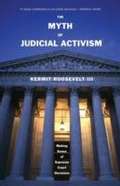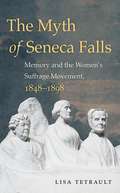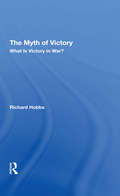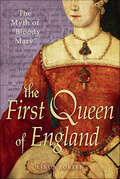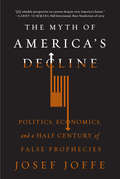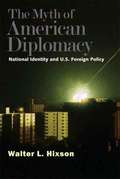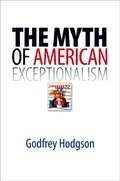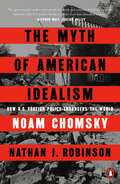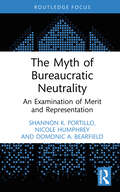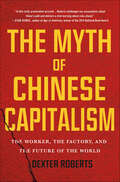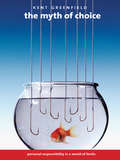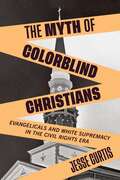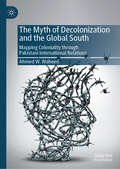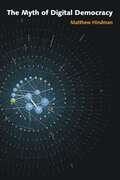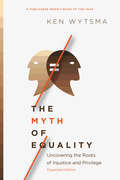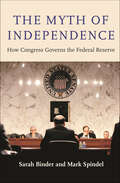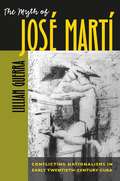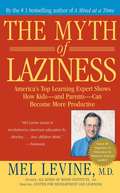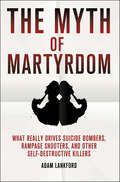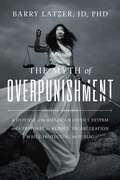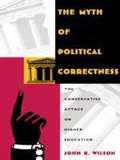- Table View
- List View
The Myth Of Judicial Activism
by Kermit RooseveltThis carefully considered book is a welcome addition to the debate over "judicial activism." Constitutional scholar Kermit Roosevelt III offers an elegantly simple way to resolve the heated discord between conservatives, who argue that the Constitution is immutable, and progressives, who insist that it is a living document that must be reinterpreted in new cultural contexts so that its meaning evolves. Roosevelt uses plain language and compelling examples to explain how the Constitution can be both a constant and an organic document. Recent years have witnessed an increasing drumbeat of complaints about judicial behavior, focusing particularly on Supreme Court decisions that critics charge are reflections of the Justices' political preferences rather than enforcement of the Constitution. The author takes a balanced look at these controversial decisions through a compelling new lens of constitutional interpretation. He clarifies the task of the Supreme Court in constitutional cases, then sets out a model to describe how the Court creates doctrine to implement the meaning of the Constitution. Finally, Roosevelt uses this model to show which decisions can be justified as legitimate and which cannot.
The Myth Of Seneca Falls: Memory And The Women's Suffrage Movement, 1848-1898
by Lisa TetraultThe story of how the women's rights movement began at the Seneca Falls convention of 1848 is a cherished American myth. The standard account credits founders such as Elizabeth Cady Stanton, Susan B. Anthony, and Lucretia Mott with defining and then leading the campaign for women's suffrage. In her provocative new history, Lisa Tetrault demonstrates that Stanton, Anthony, and their peers gradually created and popularized this origins story during the second half of the nineteenth century in response to internal movement dynamics as well as the racial politics of memory after the Civil War. The founding mythology that coalesced in their speeches and writings--most notably Stanton and Anthony's History of Woman Suffrage--provided younger activists with the vital resource of a usable past for the ongoing struggle, and it helped consolidate Stanton and Anthony's leadership against challenges from the grassroots and rival suffragists. As Tetrault shows, while this mythology has narrowed our understanding of the early efforts to champion women's rights, the myth of Seneca Falls itself became an influential factor in the suffrage movement. And along the way, its authors amassed the first archive of feminism and literally invented the modern discipline of women's history.
The Myth Of Victory: What Is Victory In War?
by Richard W HobbsRichard Hobbs examines one of society’s greatest problems: the need for reconciliation between the democratic dislike of war and the appropriate use of the military instrument in world politics. He questions whether the results obtained in war are worth the expenditures made and contends that victory gained from total war—war pushed to its outer li
The Myth That Will Not Die: The Formation of the National Government 1931 (Routledge Revivals)
by Humphry BerkeleyNo figure in the Labour movement has attracted such extremes of emotion as has James Ramsay MacDonald. Loved and almost worshipped for more than 30 years, his formation of the National Government in August 1931 incurred hatred, bitterness and contempt from those whom he had led for so long. MacDonald’s career and the admiration and odium which it engendered is without parallel in British politics. Originally published in 1978, this book provides an answer to the charge that MacDonald deliberately betrayed the Labour movement by forming a coalition government with the Conservative and Liberal Parties. It examines the criticism that he ruthlessly proceeded to destroy the Labour Party in the General Election of October 1931 – an election which he pledged, only two months earlier, would not be held. Using the private papers and authorised (auto)biographies, and the Cabinet minutes of the day, this book reconstructs what really happened between August 1 and 24 1931, and accounts for the mercilessness with which he is remembered by the Labour Party.
The Myth about Global Civil Society
by Daniela TepeIn order to help the understanding of international campaigning activities of Non-Governmental Organisations, Tepe analyses the domestic politics of the International Campaign to Ban Landmines and provides a theoretical framework through which to access these.
The Myth of "Bloody Mary": The First Queen of England
by Linda PorterIn this groundbreaking new biography of "Bloody Mary," Linda Porter brings to life a queen best remembered for burning hundreds of Protestant heretics at the stake, but whose passion, will, and sophistication have for centuries been overlooked.Daughter of Henry VIII and Katherine of Aragon, wife of Philip of Spain, and sister of Edward VI, Mary Tudor was a cultured Renaissance princess. A Latin scholar and outstanding musician, her love of fashion was matched only by her zeal for gambling. It is the tragedy of Queen Mary that today, 450 years after her death, she remains the most hated, least understood monarch in English history.Linda Porter's pioneering new biography—based on contemporary documents and drawing from recent scholarship—cuts through the myths to reveal the truth about the first queen to rule England in her own right. Mary learned politics in a hard school, and was cruelly treated by her father and bullied by the strongmen of her brother, Edward VI. An audacious coup brought her to the throne, and she needed all her strong will and courage to keep it. Mary made a grand marriage to Philip of Spain, but her attempts to revitalize England at home and abroad were cut short by her premature death at the age of forty-two. The first popular biography of Mary in thirty years, The First Queen of England offers a fascinating, controversial look at this much-maligned queen.
The Myth of America's Decline: Politics, Economics, and a Half Century of False Prophecies
by Josef Joffe"A bracing and intelligent reminder that, for all its woes, America remains extraordinarily dynamic, innovative, and resilient."--Fareed Zakaria Hailed by the Wall Street Journal as one of the best books of 2013, The Myth of America's Decline is a highly provocative look at how the United States, for all its failings, continues to be the leading business, political, and intellectual model for all other nations. In a world where America bashers constantly chortle that the United States is in decline, Josef Joffe, using lively historical examples and empirical economic models, demonstrates that these doomsday contentions are flawed, and that America--even when compared with a resurgent China--is the land where the future is being born.
The Myth of American Diplomacy: National Identity and U.S. Foreign Policy
by Walter L. HixsonThe Myth of American Diplomacy shows the deep connections between American foreign policy and the domestic culture from which it springs. Hixson investigates the national narratives that help to explain ethnic cleansing of Indians, nineteenth-century imperial thrusts in Mexico and the Philippines, the two World Wars, the Cold War, the Iraq War, and today's war on terror.
The Myth of American Exceptionalism
by Godfrey HodgsonThe idea that the United States is destined to spread its unique gifts of democracy and capitalism to other countries is dangerous for Americans and for the rest of the world, warns Godfrey Hodgson in this provocative book.
The Myth of American Idealism: How U.S. Foreign Policy Endangers the World
by Noam Chomsky Nathan J. Robinson&“For anyone wanting to find out more about the world we live in . . . there is one simple answer: read Noam Chomsky.&” —The New StatesmanA sharp indictment of both American foreign policy and the national myths that support it, and an urgent warning of the threat that U.S. power poses to humanity&’s futureThe Myth of American Idealism offers a timely and comprehensive introduction to the incisive critiques of U.S. power that have made Noam Chomsky one of the most widely known public intellectuals of all time. Surveying the history of U.S. military and economic activity around the world, Chomsky and coauthor Nathan J. Robinson vividly trace the way the American pursuit of global domination has wrought havoc in country after country.Chomsky and Robinson offer penetrating accounts of Washington&’s relationship with the Global South, its role in the Israeli-Palestinian conflict, and the wars in Iraq and Afghanistan—all justified with noble stories about humanitarian missions and the benevolent intentions of American policymakers. The same myths that have led to repeated disastrous wars, they argue, are now imperiling humanity&’s future. Examining nuclear proliferation and climate change, they show how U.S. policies are continuing to exacerbate global threats.For well over half a century, Noam Chomsky has committed himself to exposing governing ideologies and criticizing his country&’s unchecked power. At once thorough and devastating, urgent and provocative, The Myth of American Idealism offers a highly readable entry to a lifetime of thought and activism.
The Myth of Bureaucratic Neutrality: An Examination of Merit and Representation
by Shannon K. Portillo Nicole M. Humphrey Domonic A. BearfieldIn a system discredited by political corruption, the notion of ‘bureaucratic neutrality’ was presented during the Progressive era as strategy to restore legitimacy in government. However, bureaucratic neutrality also served as a barrier to equity in government. This book argues that neutrality is a myth that has been used as a means to oppress marginalized communities, largely disconnected from its origins within the field of public administration. A historical perspective of how the field has understood race and gender demonstrates how it has centered whiteness, masculinity, and heteronormativity in research and administrative practices, mistaking them for neutrality in public service. Using a historically grounded positionality approach, the authors trace the myth of bureaucratic neutrality back to its origins and highlight how it has institutionalized inequity, both legally and culturally. Ultimately, the authors demonstrate that the only way to move towards equity is to understand how inequity has become institutionalized, and to constantly work to improve our systems and decision making. With constituents across the globe demanding institutional changes in government that will establish new practices and mediate generations of inequality, The Myth of Bureaucratic Neutrality is required reading for public administration scholars, practitioners, and students.
The Myth of Chinese Capitalism: The Worker, the Factory, and the Future of the World
by Dexter RobertsThe “vivid, provocative” untold story of how restrictive policies are preventing China from becoming the world’s largest economy (Evan Osnos).Dexter Roberts lived in Beijing for two decades working as a reporter on economics, business and politics for Bloomberg Businessweek. In The Myth of Chinese Capitalism, Roberts explores the reality behind today’s financially-ascendant China and pulls the curtain back on how the Chinese manufacturing machine is actually powered.He focuses on two places: the village of Binghuacun in the province of Guizhou, one of China’s poorest regions that sends the highest proportion of its youth away to become migrants; and Dongguan, China’s most infamous factory town located in Guangdong, home to both the largest number of migrant workers and the country’s biggest manufacturing base. Within these two towns and the people that move between them, Roberts focuses on the story of the Mo family, former farmers-turned-migrant-workers who are struggling to make a living in a fast-changing country that relegates one-half of its people to second-class status via household registration, land tenure policies and inequality in education and health care systems.In The Myth of Chinese Capitalism, Dexter Roberts brings to life the problems that China and its people face today as they attempt to overcome a divisive system that poses a serious challenge to the country’s future development. In so doing, Roberts paints a boots-on-the-ground cautionary picture of China for a world now held in its financial thrall.Praise for The Myth of Chinese Capitalism“A gimlet-eyed look at an economic miracle that may not be so miraculous after all.” —Kirkus Reviews“A clearheaded and persuasive counter-narrative to the notion that the Chinese economic model is set to take over the world. Readers looking for an informed and nuanced perspective on modern China will find it here.” —Publishers Weekly“A sophisticated and readable take of China’s triumphs and crises. . . . A first-hand witness to China’s transformation over the past quarter century, Roberts credibly challenges the myth of China’s inevitable rise and global dominance.” —Ian Johnson, Pulitzer Prize–winning author and Beijing-based correspondent“A potent mix of personal stories and deft analysis, The Myth of Chinese Capitalism takes a hard look at China’s migrants and rural people.” —Mei Fong, Pulitzer Prize–winning journalist and author of One Child: The Story of China’s Most RadicalExperiment
The Myth of Choice
by Kent GreenfieldAmericans are fixated on the idea of choice. Our political theory is based on the consent of the governed. Our legal system is built upon the argument that people freely make choices and bear responsibility for them. And what slogan could better express the heart of our consumer culture than "Have it your way"? In this provocative book, Kent Greenfield poses unsettling questions about the choices we make. What if they are more constrained and limited than we like to think? If we have less free will than we realize, what are the implications for us as individuals and for our society? To uncover the answers, Greenfield taps into scholarship on topics ranging from brain science to economics, political theory to sociology. His discoveries--told through an entertaining array of news events, personal anecdotes, crime stories, and legal decisions--confirm that many factors, conscious and unconscious, limit our free will. Worse, by failing to perceive them we leave ourselves open to manipulation. But Greenfield offers useful suggestions to help us become better decision makers as individuals, and to ensure that in our laws and public policy we acknowledge the complexity of choice.
The Myth of Colorblind Christians: Evangelicals and White Supremacy in the Civil Rights Era
by Jesse CurtisA history of the hidden roots of white evangelicalism&’s contemporary racial crisis. In the decades after the civil rights movement, white Americans turned to an ideology of colorblindness. Personal kindness, not systemic reform, seemed to be the way to solve racial problems. In those same decades, a religious movement known as evangelicalism captured the nation&’s attention and became a powerful political force. In The Myth of Colorblind Christians, Jesse Curtis shows how white evangelicals&’ efforts to grow their own institutions created an evangelical form of whiteness, infusing the politics of colorblindness with sacred fervor. Curtis argues that white evangelicals deployed a Christian brand of colorblindness to protect new investments in whiteness. While black evangelicals used the rhetoric of Christian unity to challenge racism, white evangelicals repurposed this language to silence their black counterparts and retain power, arguing that all were equal in Christ and that Christians should not talk about race. As white evangelicals portrayed movements for racial justice as threats to Christian unity and presented their own racial commitments as fidelity to the gospel, they made Christian colorblindness into a key pillar of America&’s religio-racial hierarchy. In the process, they anchored their own identities and shaped the very meaning of whiteness in American society. At once compelling and timely, The Myth of Colorblind Christians exposes how white evangelical communities avoided antiracist action and continue to thrive today.
The Myth of Decolonization and the Global South: Mapping Coloniality through Pakistani International Relations
by Ahmed W. WaheedIn recent years, scholars of International Relations have increasingly turned their attention to the question of how to decolonize knowledge. While emerging debates and initiatives mark a critical step toward exposing the discipline&’s embedded power structures, there remains a striking lack of systematic empirical research into how these asymmetries are reproduced and experienced within the Global South itself. This book explores the coloniality of power and knowledge in Pakistan through an examination of Pakistani International Relations. It not only unveils the hegemonic processes embedded within the western capitalist structures of knowledge production but also explores how the eurocentrism of International Relations in Pakistan is sustained and maintained through a coloniality of knowledge and power which is designed to promote western epistemologies and emulate western standards. This book, consequently, provides a view of epistemic oppression from below. In doing so, it is an initial attempt to explore how the process of decolonization can begin to address the issues embedded in the coloniality of knowledge demonstrated through an exploration of the International Relations discipline in Pakistan.
The Myth of Digital Democracy
by Matthew HindmanIs the Internet democratizing American politics? Do political Web sites and blogs mobilize inactive citizens and make the public sphere more inclusive? The Myth of Digital Democracy reveals that, contrary to popular belief, the Internet has done little to broaden political discourse but in fact empowers a small set of elites--some new, but most familiar. Matthew Hindman argues that, though hundreds of thousands of Americans blog about politics, blogs receive only a miniscule portion of Web traffic, and most blog readership goes to a handful of mainstream, highly educated professionals. He shows how, despite the wealth of independent Web sites, online news audiences are concentrated on the top twenty outlets, and online organizing and fund-raising are dominated by a few powerful interest groups. Hindman tracks nearly three million Web pages, analyzing how their links are structured, how citizens search for political content, and how leading search engines like Google and Yahoo! funnel traffic to popular outlets. He finds that while the Internet has increased some forms of political participation and transformed the way interest groups and candidates organize, mobilize, and raise funds, elites still strongly shape how political material on the Web is presented and accessed. The Myth of Digital Democracy. debunks popular notions about political discourse in the digital age, revealing how the Internet has neither diminished the audience share of corporate media nor given greater voice to ordinary citizens.
The Myth of Equality: Uncovering the Roots of Injustice and Privilege
by Ken Wytsma2017 Foreword INDIES Book Award Honorable MentionPublishers Weekly'sIs privilege real or imagined?
The Myth of Green Marketing
by Toby SmithIn this groundbreaking study, Toby Smith analyses the role that social myths such as green marketing play in public understanding of the environmental crisis. This book introduces the concept of hegemony into environmental politics, using the concept to elucidate the political, economic, and social alliance that sustains our belief in industrial expansionism. The ecological crisis of the late twentieth century presents a challenge to the very foundations of this alliance. The hegemonic system reacts to a threat to its structure by producing social myths that provide a common sense understanding of the threat. Smith examines one such social myth, the contemporary phenomenon known as green marketing, and how it came to reinforce, rather than challenge, the ethics of productivism. By analysing green marketing as it relates primarily to the early 1990s corporate campaigns of companies such as McDonald's, Shell Chemicals, and Mobil Chemical Co., Smith demonstrates how these voices weave together an understanding of green consumerism using familiar language from economic and liberal democratic discourses. The Myth of Green Marketing is an original and important contribution to the field of environmental studies. As the first book on green marketing, it is sure to raise controversy with its unique discussion of the cultural and social aspects of environmental issues.
The Myth of Independence: How Congress Governs the Federal Reserve
by Mark Spindel Sarah BinderBorn out of crisis a century ago, the Federal Reserve has become the most powerful macroeconomic policymaker and financial regulator in the world. The Myth of Independence traces the Fed’s transformation from a weak, secretive, and decentralized institution in 1913 to a remarkably transparent central bank a century later. Offering a unique account of Congress’s role in steering this evolution, Sarah Binder and Mark Spindel explore the Fed’s past, present, and future and challenge the myth of its independence.Binder and Spindel argue that recurring cycles of crisis, blame, and reform propelled lawmakers to create and revamp the powers and governance of the Fed at critical junctures, including the Panic of 1907, the Great Depression, the postwar Treasury-Fed Accord, the inflationary episode of the 1970s, and the recent financial crisis. Marshaling archival sources, interviews, and statistical analyses, the authors pinpoint political and economic dynamics that shaped interactions between the legislature and the Fed, and that have generated a far stronger central bank than anticipated at its founding. The Fed today retains its unique federal style, diluting the ability of lawmakers and the president to completely centralize control of monetary policy.In the long wake of the financial crisis, with economic prospects decidedly subpar, partisan rivals in Congress seem poised to continue battling over the Fed’s statutory mandates and the powers given to achieve them. Examining the interdependent relationship between America’s Congress and its central bank, The Myth of Independence presents critical insights about the future of monetary and fiscal policies that drive the nation’s economy.
The Myth of Indigenous Caribbean Extinction: Continuity and Reclamation in Borikén (Puerto Rico)
by T. CastanhaThis book debunks one of the greatest myths ever told in Caribbean history: that the indigenous peoples who encountered a very lost Christopher Columbus are 'extinct.' Through the uncovering of recent ethnographical data, the author reveals extensive narratives of Jíbaro Indian resistance and cultural continuity on the island of Borikén.
The Myth of José Martí
by Lillian GuerraFocusing on a period of history rocked by four armed movements, Lillian Guerra traces the origins of Cubans' struggles to determine the meaning of their identity and the character of the state, from Cuba's last war of independence in 1895 to the consolidation of U.S. neocolonial hegemony in 1921. Guerra argues that political violence and competing interpretations of the "social unity" proposed by Cuba's revolutionary patriot, Jose Marti, reveal conflicting visions of the nation--visions that differ in their ideological radicalism and in how they cast Cuba's relationship with the United States.As Guerra explains, some nationalists supported incorporating foreign investment and values, while others sought social change through the application of an authoritarian model of electoral politics; still others sought a democratic government with social and economic justice. But for all factions, the image of Marti became the principal means by which Cubans attacked, policed, and discredited one another to preserve their own vision over others'. Guerra's examination demonstrates how competing historical memories and battles for control of a weak state explain why polarity, rather than consensus on the idea of the "nation" and the character of the Cuban state, came to define Cuban politics throughout the twentieth century.
The Myth of Laziness
by Mel LevineHow many times have you heard a teacher say that your child has tremendous potential "if only he'd just apply himself" or "if only she'd work just a little harder"? How often have you said the same thing to your son or daughter? Or perhaps you have a coworker who can't seem to finish anything; his reports are never in on time, or her projects are always behind schedule. No matter what excuses you hear, you suspect that laziness is the real reason for your colleague's low productivity. Almost no one is actually lazy, says Dr. Mel Levine, author of the #1 national bestseller A Mind at a Time. Low productivity -- whether in school or on the job -- is almost always caused by a genuine problem, a neuro-developmental dysfunction. Despite this, untold numbers of people have been stigmatized by unfair accusations of laziness, many of them adults who still carry emotional scars from their school days. In The Myth of Laziness Dr. Levine shows how we can spot the neurodevelopmental dysfunctions that may cause "output failure," as he calls it, whether in school or in the workplace. Dr. Levine identifies seven forms of dysfunction that obstruct output. Drawing on his years of clinical experience he describes eight people -- children, adolescents, and adults -- he has worked with who exhibited one or another of these problems. He shows how identifying the problem can make all the difference, leading to a course of corrective action rather than to accusations of laziness and moral failure. For example, a child who is unable to plan or to think ahead, who cannot consider different methods of accomplishing something or has difficulty making choices may wait until it is too late to complete an assignment or may act impulsively, creating a pattern of bad judgments and careless errors. Dr. Levine explains how such a child can be helped to learn how to plan ahead and weigh various alternatives. This sort of problem, if untreated, can persist into adulthood, where it can wreak far more havoc than in the classroom. The Myth of Laziness explains the significance of writing as a key barometer of productivity during the school years. Because writing brings together so many neurodevelopmental functions -- such as memory, motor control, organization, and verbalization of ideas -- it can provide crucial clues to pinpoint the sources of output failure. With its practical advice and its compassionate tone, The Myth of Laziness shows parents how to nurture their children's strengths and improve their classroom productivity. Most important, it shows how correcting these problems in childhood will help children live a fulfilling and productive adult life.
The Myth of Martyrdom: What Really Drives Suicide Bombers, Rampage Shooters, and Other Self-Destructive Killers
by Adam LankfordThe Myth of Martyrdom presents a startling look at the deepest, darkest secrets that terrorists pray you'll never know.For decades, experts from the most powerful governments and prestigious universities around the world have told us that suicide bombers are psychologically normal men and women driven by a single-minded purpose: self-sacrifice. As it turns out, this claim originated with the terrorist leaders themselves, who insisted that they would never recruit mentally unstable people to carry out suicide attacks. As these strikes have become both increasingly common and increasingly deadly, no one has challenged this conventional wisdom. These are fearless ideological warriors, we're told, who have the same resolve and commitment to their beliefs as our own Navy SEALs, because they're willing to die for the sake of their cause.In The Myth of Martyrdom, Adam Lankford argues that these so-called experts have it all wrong. The truth is that most suicide terrorists are like any other suicidal person—longing to escape from unbearable pain, be it depression, anxiety, marital strife, or professional failure. Their "martyrdom" is essentially a cover for an underlying death wish. Drawing on an array of primary sources, including suicide notes, love letters, diary entries, and martyrdom videos, Lankford reveals the important parallels that exist between suicide bombers, airplane hijackers, cult members, and rampage shooters. The result is an astonishing account of rage and shame that will transform the way we think of terrorism forever.We can't hope to stop these deadly attacks, Lankford argues, until we understand what's really behind them. This timely and provocative book flips a decades-old argument on its head—and has huge implications for our future.
The Myth of Overpunishment: A Defense of the American Justice System and a Proposal to Reduce Incarceration While Protecting the Public
by Barry Latzer Tom CottonJustice is on trial in the United States.From police to prisons, the justice system is accused of overpunishing. It is said that too many Americans are abused by the police, arrested, jailed, and imprisoned. But the denunciations are overblown. The data indicates, contrary to the critics, that we don&’t imprison too many, nor do we overpunish. This becomes evident when we examine the crimes of prisoners and the actual time served. The history of punishment in the United States, discussed in vivid detail, reveals that the treatment of offenders has become progressively more lenient. Corporal punishment is no more. The death penalty has become a rarity. Many convicted defendants are given no-incarceration sentences. Restorative justice may be a good thing for low-level offenses, or as an add-on for remorseful prisoners, but when it comes to major crimes it is no substitute for punitive justice. The Myth of Overpunishment presents a workable and politically feasible plan to electronically monitor arrested suspects prior to adjudication (bail reform), defendants placed on probation, and parolees.
The Myth of Political Correctness: The Conservative Attack on Higher Education
by John K. WilsonThe classics of Western culture are out, not being taught, replaced by second-rate and Third World texts. White males are a victimized minority on campuses across the country, thanks to affirmative action. Speech codes have silenced anyone who won't toe the liberal line. Feminists, wielding their brand of sexual correctness, have taken over. These are among the prevalent myths about higher education that John K. Wilson explodes.The phrase "political correctness" is on everyone's lips, on radio and television, and in newspapers and magazines. The phenomenon itself, however, has been deceptively described. Wilson steps into the nation's favorite cultural fray to reveal that many of the most widely publicized anecdotes about PC are in fact more myth than reality. Based on his own experience as a student and in-depth research, he shows what's really going on beneath the hysteria and alarmism about political correctness and finds that the most disturbing examples of thought policing on campus have come from the right. The image of the college campus as a gulag of left-wing totalitarianism is false, argues Wilson, created largely through the exaggeration of deceptive stories by conservatives who hypocritically seek to silence their political opponents.Many of today's most controversial topics are here: multiculturalism, reverse discrimination, speech codes, date rape, and sexual harassment. So are the well-recognized protagonists in the debate: Dinesh D'Souza, William Bennett, and Lynne Cheney, among others. In lively fashion and in meticulous detail, Wilson compares fact to fiction and lays one myth after another to rest, revealing the double standard that allows "conservative correctness" on college campuses to go unchallenged.
